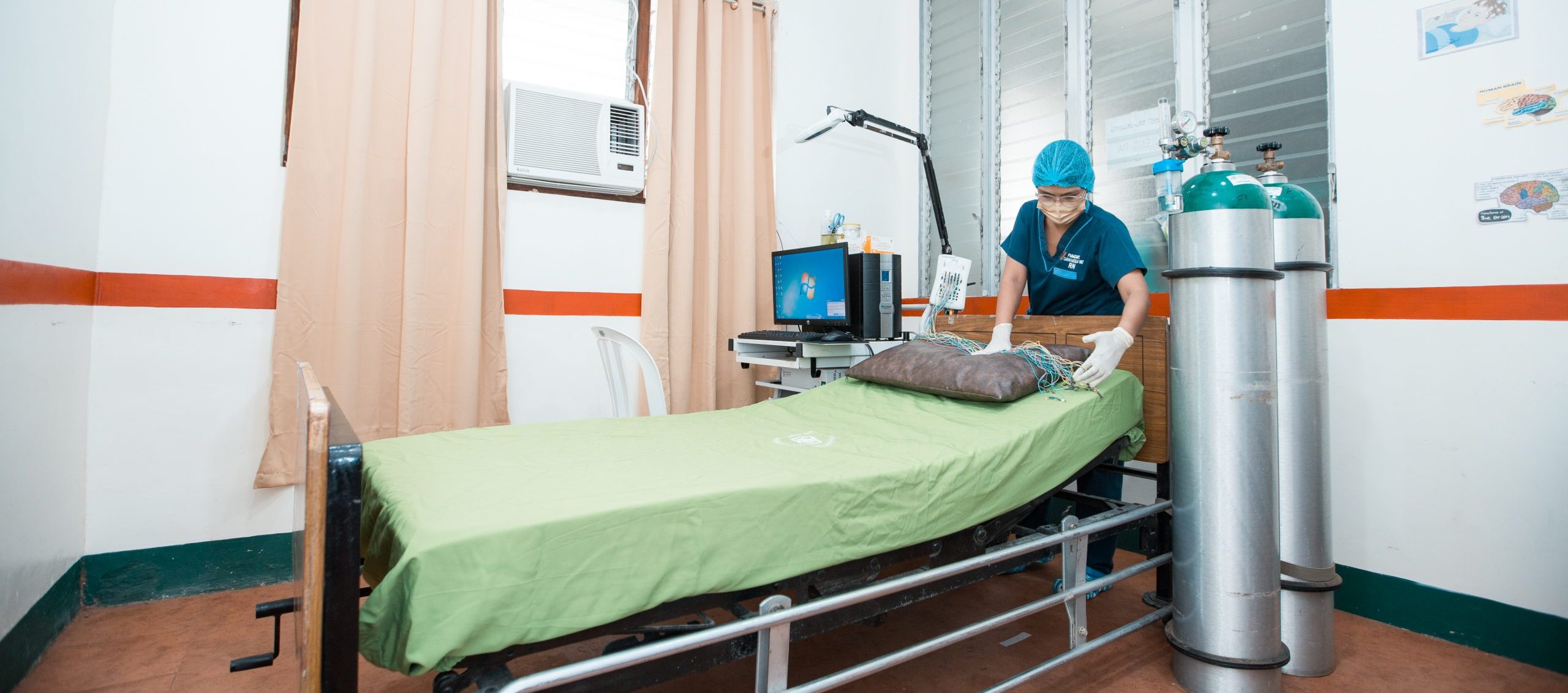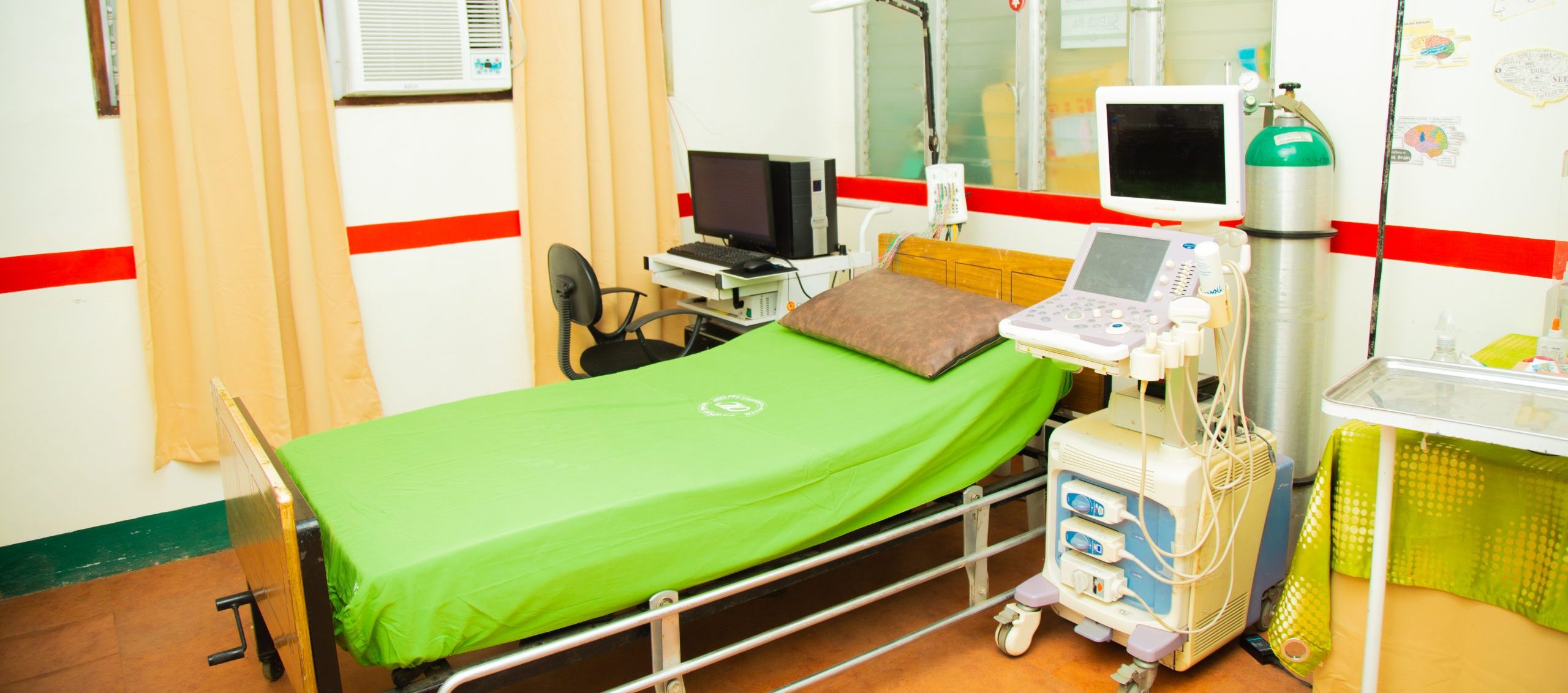SERVICES OFFERED:
• Basic EEG
• Sleep-Deprived EEG
Operating Hours: Monday to Saturday: 8 AM to 5 PM
PROCEDURE DESCRIPTION:
Basic Electroencephalography – refers to the recording of spontaneous electrical activity of the brain for the span of 30 minutes. The patient is awake during the entire procedure with eyes closed; but it is okay if the patient falls asleep.
Sleep-Deprived Electroencephalography – refers to the recording of spontaneous electrical brain activity for a span of 45 minutes. In sleep-deprived EEG, patients are instructed to sleep for a maximum of 4 hours depriving them of the required sleeping hours which is 6 – 8 hours.
PATIENT PREPARATION
1. Patients are instructed to shampoo hair without conditioner. After which, when it is dry, no oil or gel are to be applied.
2. If patients are debilitated e.g., comatose and unable to meet the condition, scrub is applied.
For Sleep Deprived EEG
1. The Family members/Parents of the patient are instructed that the maximum sleep the night before the EEG schedule for the patient is only 4 hours, thereafter no power naps or short sleep should occur prior to the EEG exam.
2. Anticonvulsant medications and other sleep depressant medications for the night and morning after should be put on hold and administered only when the EEG exam is done. Should the patient cannot sleep during the procedure and the exam can’t be done, the attending physician is contacted for any medications to be administered in order to perform the exam.
3. Same preparations for the scalp are also applied for sleep-deprived EEG.
POLICIES AND PROCEDURES
• EEG applies to all patients, from neonates to adults.
• Operational hours: Monday to Saturday 8 AM to 5 PM. Stat and On Call orders as necessary.
• Scheduling of patients is done personally or via phone call. In case there are no scheduled patients for the day, patients are catered via first come, first served as long as they meet the right patient preparation.
• Official results are released 2-3 working days. However, in case there are patients who need the results immediately, their results are prioritized and released as soon as possible.
• For patients who are read by the pediatric electroencephalographer, results are released after 3-5 working days. However, if the patient is admitted in the hospital, results are prioritized.
• Patients who are requested with Sleep-deprived EEG but are unable to sleep during the entire procedure (45 Minutes), their procedure will proceed until 45 minutes and will not be extended.
• Patients from other hospitals are accompanied by their nurses; however, if they are not, a nurse from the ward is called to stand by. Outpatients who have a medical history of seizure attacks are required to have a nurse on standby. If so, a nurse is called to stay during the entire procedure.
• EEG is done after the patients have settled accounts.
• For patients who have requests for EEG and has HMOs, approval from their institution is required first. After which, requests should be signed by the information clerk on duty.
ELECTROENCEPHALOGRAPHY EXAM PROPER:
Policies and Obligations:
1. The examination room should always be clean and prepared for the examination of the next patient.
2. Enough linen should be in stock to be prepared for the number of patients ahead.
3. Fresh linens should be changed as necessary.
4. There should be enough forms to be in stock for the day.
5. Ensures that there is enough paste and micropore in stock for the examination.
6. Equipment is checked first prior to any examination.
7. The patient’s data should be written in the general entry logbook.
8. The reading physician should be informed immediately after the examination of the patient.
9. After the procedure, the electrodes are soaked in water and should be wiped dry after the paste has been dissolved.
10. Cleaning of the equipment and the room should be done every day or as necessary.
Responsibilities:
1. The EEG technologist functions efficiently and effectively in demonstrating conduct and attitudes reflecting to the profession:
• Responds to patients’ need
• Perform tasks accurately and competently
• Equipped with comprehensive knowledge of all aspects of the examination
2. The EEG technologist provides service to patients without discrimination.
• Has proper communication skills
• Exhibits no prejudice for sex, race, creed, and religion
• Provides services without regard to social and economic status
• Delivers care unrestricted by concerns for personal attributes, nature of the disease or illness
3. The EEG technologist exercise care, discretion, and judgment in the practice of the profession.
• Assumes responsibility for professional decisions
• Assesses situations and acts in the best interest of the patient
4. The EEG technologist provides the physician with pertinent information related to the diagnosis and treatment management of the patient.
• Complies with the fact that the diagnosis and interpretation are outside the scope or practice of the profession
• Acts as an agent to obtain medical information through observation and communication to aid the physician in diagnosis, treatment, and management
PROCESSING OF OUTPATIENT INDIVIDUALS:
1. The patient shall present the request for the performance of the procedure from his/her attending physician.
2. The information clerk on duty shall encode the patient’s data.
3. Pay to the cashier for cash basis and if payment is thru HMO’s, PCSO etc; Approval from the HMO, PCSO shall be acquired first before the scheduling/performance of the procedure.
4. For the results, the patient will be contacted via text or phone call when the results are ready for release.
PROCESSING OF INPATIENT REQUESTS:
1. The Nurse assistant/Nurse on duty hands over the cost center of the patient.
2. The examination of the stop charged patient must be paid in cash prior to the duty procedure.
3. Obtain necessary information from the patient’s chart.
4. Inform the patient of the procedure to be done. Explain the procedure, its purpose, duration and the necessary preparations. Obtain vital signs as necessary.
For patients ok to be transported to the examination room:
• Before transport to the examination room, the nurse station is informed.
• Relatives/Folks of the patient can accompany the patient during the examination.
• The patient is then transported back to his/her room and the nurse station is informed of the transport.


